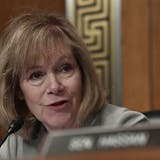Minnesota's high school graduation rate dipped slightly in 2021, according to data released Wednesday by the state Department of Education that reflects how students fared during the height of the pandemic.
About 83% of seniors graduated on time last year, a half-percentage-point drop from 2020.
Nearly every student group posted a dip in the percentage graduating on time in 2021, and stubborn achievement gaps persisted. But Black students posted a slight increase of 1 percentage point to 70%. High school seniors who identify as two or more races also saw gains of about 1 percentage point to nearly 75%.
Latino students and those who are learning English as a second language posted the steepest drops of any demographic, as did students eligible for free or reduced-price meals.
"The class of 2021 faced incredibly difficult circumstances in their final years of high school," state Education Commissioner Heather Mueller said in a statement Wednesday.
As many students struggled with distance learning, some districts adjusted their grading policies in order to help pupils stay afloat.
Among the state's three largest districts, Anoka-Hennepin posted gains while Minneapolis and St. Paul saw slight decreases in the percentage of students graduating on time.
Anoka-Hennepin's four-year completion rate was nearly 89%, nearly 3 percentage points higher than in 2020. In St. Paul, 76% of the district's high schoolers graduated on time, more than 2 percentage points lower than the prior year. And in Minneapolis, the district posted a four-year completion rate of a little less than 74%, about half a percentage point less than in 2020.


